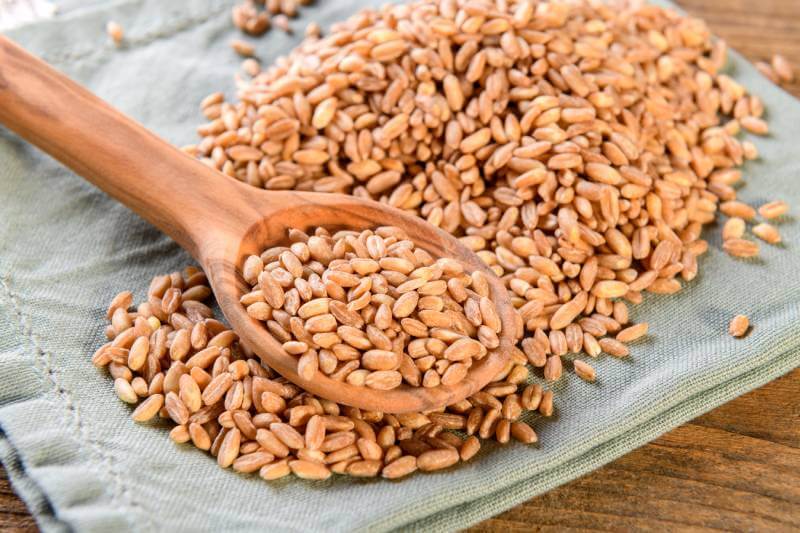Can Dogs Eat Farro? What You Need To Know
Farro, an ancient grain, is gaining popularity for its nutritional benefits. It’s a type of wheat characterized by its unaltered genetic structure, making it one of the ancient grains. Available in varieties like Einkorn, Emmer, and Spelt, Farro offers a nutty flavour and chewy texture when cooked.
Contents
Can Dogs Eat Farro?
Dogs can eat cooked farro in moderation. It’s a nutritious whole grain rich in fiber, protein, and essential nutrients. However, avoid feeding it to dogs with gluten sensitivities or grain allergies. Always introduce new foods gradually and consult your veterinarian.
Key Takeaway
Farro isn’t gluten-free and contains about 150 calories, 1g fat, 32g carbohydrates, and 6g protein per 1/4 cup. While generally safe for dogs without grain allergies or gluten intolerance, monitor their reactions closely. Consult your vet before incorporating Farro into your dog’s diet.
Nutritional Benefits and Risks
Farro boasts nutritional value, offering fibre, essential fatty acids, and antioxidants beneficial for dogs’ immune systems and skin health. However, dogs with grain sensitivities may experience digestive issues like bloating or diarrhea. Avoid Farro if your dog shows signs of discomfort or allergies.
Dos And Don’ts
For dogs without grain sensitivities, cooked Farro can be a healthy addition to their diet in moderation. Ensure balanced nutrition with high-quality dog food, or consult your vet for homemade meal plans. Avoid feeding uncooked grains to dogs, as it may cause gastrointestinal distress.
Safe Preparation Methods and Creative Treats
To prepare Farro for your dog, cook it thoroughly to aid digestion. Serve it plain or mix it with dog-friendly ingredients like lean meats or vegetables. Homemade farro treats can be nutritious, but ensure they’re free from harmful additives or spices.
Farro Nutrient Values
| Nutrient | Value |
| Calories | 150 |
| Fat | 1g |
| Carbohydrates | 32g |
| Fiber | 3g |
| Protein | 6g |
Properties of Farro
- Ancient grain, genetically unaltered
- Nutty flavour and chewy texture
- Contains gluten
- Rich in fibre, protein, and essential nutrients
- Available in varieties like Einkorn, Emmer, and Spelt
Potential Uses for Overall Health
- Supports immune system and skin health
- Provides essential fatty acids and antioxidants
- Helps regulate blood sugar levels
Final Verdict
Farro can be a nutritious addition to your dog’s diet, offering valuable nutrients and health benefits. However, it’s crucial to consider your dog’s individual needs and potential sensitivities before incorporating Farro into their meals. Consult with your vet for personalized dietary recommendations.
NOTE: Always check with your veterinarian first before giving your cat any new foods, especially “people foods.” What might be okay for one cat might not be suitable for your cat, depending on multiple factors, such as their age, health history, health conditions, and diet. Cats on prescription diets should not be fed any food or treats outside the diet.
Related: Can Dogs Eat Ranch Dressing?
FAQs About Dogs Eating Farro
1. Can dogs eat Farro?
Generally, yes. Farro is safe for dogs without grain allergies or gluten sensitivity. However, monitoring your dog’s reaction and consult with your vet before introducing it to their diet is essential.
2. Is Farro gluten-free?
No, Farro contains gluten, as it is a type of wheat. Dogs with celiac disease or gluten intolerance should avoid Farro.
3. What are the nutritional benefits of Farro for dogs?
Farro provides fibre, essential fatty acids, protein, and antioxidants. These nutrients support the immune system and skin health and regulate blood sugar levels in dogs.
4. How should I prepare Farro for my dog?
Cook Farro thoroughly before serving it to your dog to aid digestion. Avoid seasoning or adding harmful additives. Serve plain or mix with dog-friendly ingredients like lean meats or vegetables.
5. Are there any risks associated with feeding Farro to dogs?
After consuming Farro, dogs with grain sensitivities may experience digestive issues such as bloating or diarrhea. Monitor your dog closely for any signs of discomfort or allergic reactions.
6. Can I give raw Farro to my dog?
Feeding raw Farro to dogs is not recommended as it may cause gastrointestinal distress. Always cook Farro before serving it to your dog.
7. How much Farro can I feed my dog?
Farro should be given to dogs in moderation as part of a balanced diet. Consult with your vet to determine the appropriate serving size based on your dog’s size, weight, and nutritional needs.
8. What should I do if my dog shows discomfort after eating Farro?
If your dog experiences adverse reactions such as vomiting, diarrhea, or allergic symptoms, stop feeding them Farro immediately and consult your vet for further guidance.
9. Can Farro be used as a treat for dogs?
Yes, cooked Farro can be used as a nutritious treat for dogs. However, ensure it’s cooked plain and free from harmful additives or spices.
10. Are there any alternatives to Farro for dogs with grain sensitivities?
Yes, grain-free alternatives, such as quinoa, brown rice, or barley, are available for dogs with grain sensitivities. Consult your vet to find the best dietary option for your dog.
Related Cats Guides:
- Can Cats Eat Bones?
- Can Cats Eat Chicken Broth?
- Can Cats Eat Pumpkin Seeds?
- Can Cats Eat Kale?
- Can Cats Eat Human Food?
- Can Cats Eat Crackers?
- Can Cats Eat Canned Dog Food?
- Can Cats Eat Fruit?
- Can Cats Eat Chicken Nuggets?
- Golden Retriever Pros and Cons: What Every Pet Parent Should Know - 15 September 2025
- Cane Corso Dog Breed: Health, Care, and Lifespan - 14 September 2025
- Catahoula Leopard Dogs: Description, Temperament, Lifespan, & Facts - 21 July 2025







